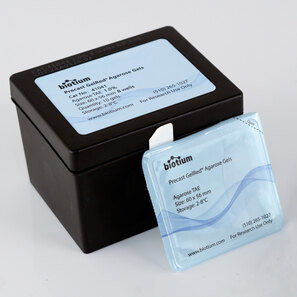Precast GelRed® Agarose Gels, 1% Agarose/TAE
Ready-to-use 1% agarose/TAE gels precast with GelRed® Nucleic Acid Gel Stain. The gels are suitable for visualizing 250-12,000 bp DNA fragments.

Precast GelRed® Agarose Gels are ready-to-use gels intended for DNA gel electrophoresis. The 1% agarose gels were cast in TAE buffer and contain highly sensitive GelRed® Nucleic Acid Gel Stain, saving a significant amount of time by eliminating the need for casting gels.
- Ready-to-use 1% agarose/TAE gels precast with GelRed®
- Saves time by eliminating the need for casting gels
- Suitable for visualizing 250-12,000 bp DNA fragments
- GelRed® is a safer and much more sensitive alternative to EtBr
- Gels available with 8 or 18 wells and sold in packs of 10 gels
Biotium offers 1X TAE (1 L) Buffer Powder Packets (Cat. No. 22031) that are suitable for use with Precast GelRed® Agarose TAE Gels.
GelRed®: A Superior Replacement for EtBr
GelRed® and ethidium bromide (EtBr) have very similar excitation and emission wavelengths, so you can directly replace EtBr with GelRed® without changing your existing imaging system. In addition, GelRed® is far more sensitive than EtBr. Staining nucleic acids with GelRed® is compatible with downstream applications such as sequencing and cloning. GelRed® can be removed from DNA using a gel extraction kit, or by phenol/chloroform extraction followed by ethanol precipitation. To learn more, learn more about GelRed® or read our GelRed® FAQs.
Non-Mutagenic and Safer for the Environment
GelRed® was subjected to a series of tests at Biotium and by three independent testing services to assess the dye’s safety for routine handling and disposal. Test results confirm that the dye is impenetrable to both latex gloves and cell membranes. The dye is non-cytotoxic and non-mutagenic at concentrations well above the working concentrations used in gel staining. GelRed® successfully passed environmental safety tests in compliance with CCR Title 22 Hazardous Waste Characterization, under which GelRed® is classified as non-hazardous waste. See the GelRed® and GelGreen® Safety Report.
See the table below for a detailed comparison of available GelRed® and GelGreen® formats.

Resources:
